1950s-1960s
1951
-
September 1951A US Corporation Pacific Consultants Incorporated (PC. Inc.) was founded
-
1951A US Corporation Pacific Consultants Incorporated (PC. Inc.) was Founded
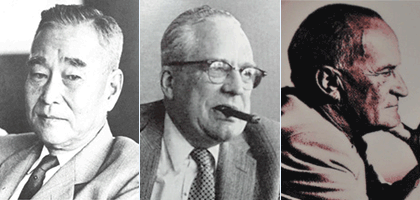
A US Corporation Pacific Consultants Incorporated (PC. Inc.) was founded with equal investment by Muneki SHIRAISHI, Eric FLOOR, and Antonin RAYMOND (registered in Delaware, USA, head office: Chicago, Tokyo branch office: Maru Bldg, Ward 424).
1954
-
February 1954A Japanese corporation PACIFIC CONSULTANTS CO., LTD. was Founded
-
February 1954A Japanese corporation PACIFIC CONSULTANTS CO., LTD. was Founded
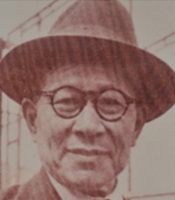
PACIFIC CONSULTANTS CO., LTD. established as a Japanese corporation.
(Tokyo, Shinjuku West Exit, Higashi Fuji Building [now Subaru Building]), capital stock JPY 300,000. -
1956Marunouchi Line Research Design
A New Route for Commuting
Technology and Knowledge Applied to Key Sections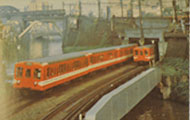
At the request of the Teito Rapid Transit Authority, we were entrusted with the research design and soil investigation of the Marunouchi Line's Kasumigaseki-Akasaka-mitsuke section. Approximately 230m of the section between Kasumigaseki and Akasaka-mitsuke was excavated using the shield method. This was the first attempt at this for a Japanese subway. Three years later, on March 15, 1959, the 5.8km section between Kasumigaseki and Shinjuku was opened, marking the opening of the entire Marunouchi Line. This was the foundation for a high-density line, with trains arriving every 1 minute and 50 seconds during the morning rush hour.
-
1958Meishin Expressway Viaduct Comparative Design
A Bridge to the Future
Symbol of the Dawn of the Highway Age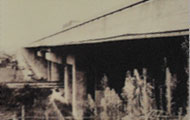
Japan's first expressway, between Tokyo and Kobe. A comparative viaduct design was commissioned to determine the best structural type in terms of various aspects, including economy and structural characteristics. Based on this design, construction of the 191km section between Komaki and Nishinomiya began in 1958. The section between Ritto and Amagasaki was opened in 1963. This was also the first civil engineering project in Japan to use the lump-sum unit price contract method, and the first competitive bidding project to include a unit price table for each type of work. The project is highly regarded for its achievement in bringing the potential of viaducts to expressways.
1959
-
April 1959Sapporo Field Office Opened (Promoted to Sapporo Branch Office in April 1965, Renamed Hokkaido Branch Office in April 1992)
-
1959-1961Metropolitan Expressway Lines 1 and 3 Upper and Lower Structural Design
The Olympics to be Held in Five Years' Time
Rapid Improvement of the Metropolitan Transportation Network
In preparation for the 1964 Tokyo Olympics, construction of "Olympic-related roads" such as Route 1 was prioritized, and our company also began structural design. To shorten the construction period, we adopted a method of "building roads over existing roads and rivers," which did not require land acquisition, and used the immersed tunnel method for the Haneda Tunnel. Metropolitan Expressway Route 1 opened in 1962, and all Olympic-related roads were opened nine days before the opening ceremony. We made full use of ideas and cutting-edge technology to achieve a construction period that would have been impossible using normal procedures.
1961
-
May 1961Nagoya Field Office Opened (Promoted to Nagoya Branch Office in April 1965, Renamed Chubu Branch Office in April 1992)
-
1961Tokaido Shinkansen Area / Bridge Design
Comfortable Travel at 200 km/h
Great Technology Handed Down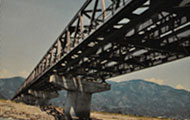
In the Tokaido Shinkansen project, we were involved in the design of the Hyugacho/Kamonomiya area and the Fuji River Bridge. The world's first and Japan's first high-speed railway was built on a separate line with standard gauge, different from the narrow gauge of the conventional line. There were many unknowns, and the project required detailed consideration of the topography and climate of the entire area along the line, and a meticulous design. The technology and know-how cultivated on this line was later passed on to other Shinkansen lines, giving birth to many descendants such as the "Hikari," "Nozomi," and "Kodama."
1962
-
May 1962Osaka Field Office Opened (Promoted to Osaka Branch Office in April 1965, and to Osaka Head Office in October 1995)
1963
-
November 1963Fukuoka Field Office Opened (Promoted to Fukuoka Branch Office in April 1965, Renamed Kyushu Branch Office in April 1992)
-
1963Tomei Expressway Road design / structure design
Transformation of the Leisure and Business Transportation
Japan's Main Artery Completed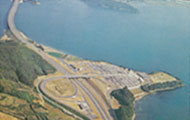
Utilizing the technology and know-how that was poured into the construction of Japan's first expressway, the Meishin Expressway, the company continued to design the approximately 350km-long expressway. In 1968, the Tokyo IC-Atsugi IC, Fuji IC-Shizuoka IC, and Okazaki IC-Komaki IC sections were opened, and the entire line was finally opened in 1969. The Tomei Expressway, along with the Tokaido Shinkansen, which opened in 1964, and the Meishin Expressway, which opened in 1965, became a major trunk line connecting Tokyo and Osaka, surpassing railroads in land freight transport.
1965
-
February 1965Sendai Field Office Opened (Promoted to Sendai Branch Office in April 1965, Renamed Tohoku Branch Office in April 1992)
-
1965Osaka International Airport Design
Towards the World Expo
Strengthening Osaka International Airport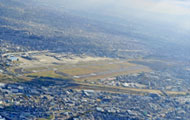
It was decided that the World Expo would be held in Osaka in 1970. In order to welcome visitors from around the world for Asia's first international exposition, the design of Osaka International Airport was entrusted to the company in 1965. Would it be able to handle the predicted volume of traffic, would it be safe, and would it link with the surrounding transportation network to smoothly get to its destination? The World Expo was a great success and attracted a lot of attention from Japan and abroad as one of the airports that symbolised Japan's rapid economic growth after the war, which made it the second largest economic power after the USA.
-
1967New Tokyo International Airport Design
A Design for the New Age of Aviation
A New International Airport for a New Age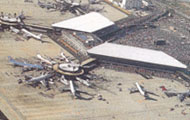
What is needed for an airport in the new age is two 4,000m runways, one 3,600m runway, and two 2,500m runways. Various other features were also desired. With such a huge airport in mind, we carried out the airport design with an eye on a new age of aviation. After opening in May 1978, it was privatized (converted into a special company) in 2004 and its name was changed to "Narita International Airport." Today, access from the city center has improved dramatically, and the airport continues to evolve every day as a gateway to the world, making use of our original ideas.
1968
-
January 1968Niigata Field Office Opened (Renamed Hokuriku Branch Office in October 2006)
-
1968Miyanomori Ski Jump Design / Management
Stage for Winning Gold, Silver and Bronze Medals
Stadium Watched over by the Hinomaru Flying Squadron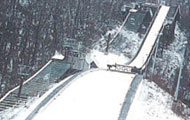
Miyanomori Ski Jump Site was newly built when Sapporo hosted the Winter Olympics in 1972. It was designed by our company in 1968 and completed in 1970, just before the pre-Olympics. At the time of its completion, the large ski jump located so close to the city center made its presence known to the world as a structure showcasing Sapporo's excellent sports environment. Even today, many competitions are held here, and the ski jump, which produces great excitement, is a popular attraction for tourists visiting Hokkaido in the summer as well as in the winter.
1970s-1990s
1971
-
1971Tanegashima Space Center Osaki Launch Complex Design
Connecting the Present and the Future
The Most Beautiful Rocket Base in the World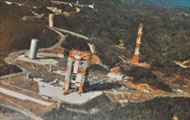
Osaki Launch Site was established within the Tanegashima Space Center for the purpose of launching practical rockets. It was designed with the image of a facility that would blend in with nature. It is the core facility of the center, and since the N-1 rocket, NASDA's (National Space Development Agency of Japan) first practical rocket, rockets based on the Delta rocket have been launched here. Artificial satellites with unique roles, including the weather satellite "Himawari," have departed from Osaki Launch Site, bringing great benefits to people.
1972
-
June 1972Okinawa Field Office Opened (Promoted to Okinawa Branch office in October 1996)
1976
-
1976Kan-Etsu Expressway Kan-Etsu Tunnel Detailed Design
Using the Latest Technology to Solve Problems
Major Changes in the Lives of People Living in Snow Area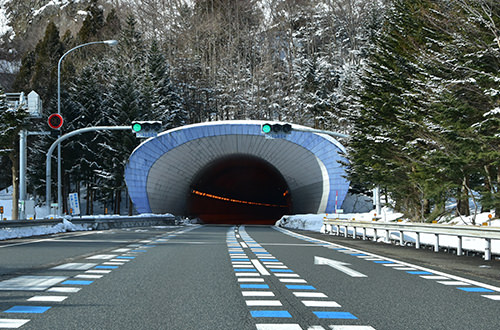
The Kan-Etsu Tunnel Project cuts through Mt. Tanigawa at an altitude of around 700m via the shortest route in a straight line. The full-face excavation method was used in the design and construction of the 11km-long tunnel. The fact that such a long tunnel could be excavated using this method was revolutionary in itself. It was provisionally opened in 1985, reducing travel time over the mountain pass by more than an hour. Japan's longest road tunnel cuts through the steep Mt. Tanigawa and is not hindered by heavy snowfall, dramatically increasing the flow of goods and people between the east and west.
1978
-
October 1978Hiroshima Field Office Opened (Promoted to Chugoku Branch Office in April 1992)
1984
-
April 1984Takamatsu Field Office Opened (Promoted to Shikoku Branch Office in April 1998)
-
November 1984Tsukuba Test Site (Renamed to Tsukuba Research Center) Opened.
-
1984Trans-Tokyo Bay Highway Environmental Study /Part 1
Combating Soft Ground and High Water Pressure
The Tokyo Bay Area Comes Together Across the Sea
The Tokyo Bay Transit Highway (nicknamed the Tokyo Bay Aqualine) runs from Kawasaki City, Kanagawa Prefecture, through Tokyo Bay to Kisarazu City, Chiba Prefecture. Our company was responsible for all environmental surveys, including air quality, vibration, water quality, ecology, and scenery. After collecting various data, including environmental surveys, and conducting repeated feasibility studies, construction finally began in 1989. The bridge section was completed in 1995, and Tunnel Dept. in 1997, and the road was opened to traffic. It connects Kawasaki and Kisarazu in 30 minutes, and is one of the trump cards that will significantly alleviate traffic congestion in the bay area.
1993
-
1993Yokohama Minato Mirai 21 Central District Basic Ground Levelling Plan
Contributing to the Design of the Central Area
A Futuristic City for the 21st Century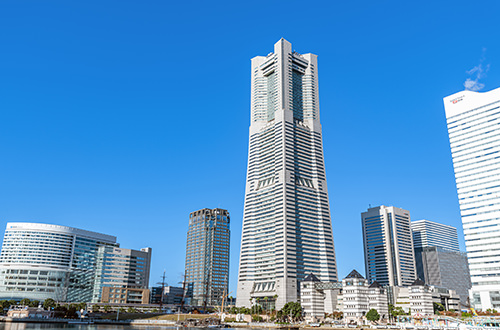
Yokohama Minato Mirai 21 is an area bordering Tokyo Bay that stretches across Nishi-ku and Naka-ku in Yokohama City. We poured our technology and know-how into the basic design for the central district leveling that is the foundation of the project. The development was carried out in a planned manner based on basic principles, with electric wires and optical fibers buried in utility tunnels together with water and sewerage. Energy conservation was also taken into consideration with efficient garbage collection and the introduction of district heating and cooling. It was developed as a futuristic city worthy of the 21st century, and in 1997 it was awarded one of the 100 Best Urban Landscapes in Japan.
1995
-
1995Hanshin Expressway Earthquake Restoration Design
Achieving Significantly Faster Full-Line Restoration
The Birth of a Strong and Environmentally Friendly Hanshin Expressway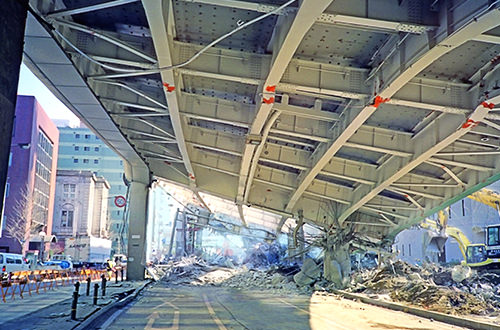
The Great Hanshin-Awaji Earthquake occurred on January 17, 1995. The collapse of the Hanshin Expressway Route 3 Kobe Line was a testament to the ferocity of the disaster. An emergency response headquarters was set up within the company on the same day. Based on information gathered on-site, measures were considered for the removal of collapsed bridges, fallen bridges, and rubble, and emergency measures such as the installation of shoring, wrapping steel plates, and girder connections were proposed for damaged structures. Furthermore, restoration work was promoted while exploring designs, technologies, and construction methods that would demonstrate resilience. The entire line was restored on September 30, 1996.
1998
-
1998Metropolitan Expressway Traffic Control System Survey
Numerous New Technologies Emerge
Traffic Information Using Technology
In 1997, Metropolitan Expressway Corporation introduced the "Comprehensive Management System" to integrate Metropolitan Expressway traffic control system. Our company was in charge of investigating this system. The Comprehensive Management System is capable of instantly detecting any abnormalities on Metropolitan Expressway, as well as distributing accurate information in real time. This has resulted in time benefits from reduced driving time, economic benefits from improved fuel efficiency through smoother driving, and reduced environmental impact through reduced CO2 emissions.
1999
-
1999Tsukuba Express Line Design
Connecting Akihabara and Tsukuba in 45-minutes
New Transportation Infrastructure for Tsukuba Science City
The plan was first drawn up in 1978. After many twists and turns, the "Metropolitan Area New Urban Railway" project was launched in 1990. After considering many points to note, such as the electrification method that would take into account the impact on the Japan Meteorological Agency's geomagnetic observatory in Kakioka, Takaoka City, Ibaraki Prefecture, the current route was decided upon, running from Akihabara through Kita-Senju to Minami Nagareyama, Moriya, and Midorino. It is not only used as a commuter route, but also plays an important role as a major route for transporting tourists from Tokyo, Chiba, and Saitama to Mount Tsukuba.
2000s-2010s
2000
-
February 2000PACIFIC CONSULTANTS GROUP Co., Ltd. Establishment
PACIFIC CONSULTANTS CO., LTD., Ltd. and PACIFIC CONSULTANTS International Co., Ltd. become wholly owned subsidiaries.
2002
-
2002Metropolitan Area Outer Underground Discharge Channel Project
Saving the Area from Flood damage
Japan's World-Class Underground Temple for Disaster Prevention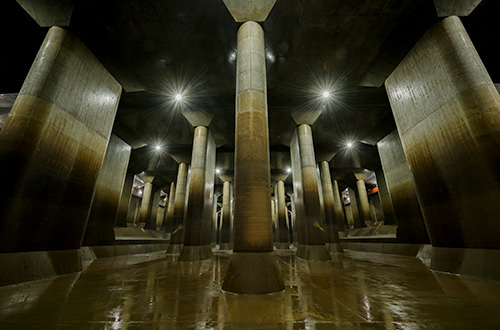
This is the world's largest flood prevention facility, which will create a 6.3km-long river 50m underground directly below National Route 16 in Kasukabe City. The project began in 1993, and involved the use of expertise in almost every aspect, from the underground tunnel section of the spillway, to the overall concept, hydraulic analysis, planning and design of the structures and facilities, and monitoring of noise, vibration, and water quality after completion. When in its normal hollow state, it resembles an underground temple. It has also been used in many filmings, including television programs, special effects, commercials, and movies.
2003
-
2003"Echika Omotesando" Model Station Project
Connecting the Subway City and the Aboveground City
The Start of the Station Boom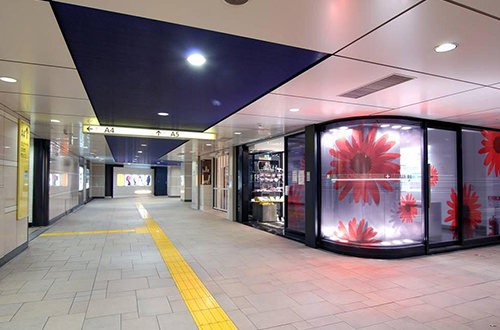
When you emerge from Omotesando Station, you will come across Brand Street, a beautiful tree-lined avenue that has been likened to the Champs-Élysées in Paris. We proposed to bring that atmosphere underground, creating a sense of unity with the city, and we were selected as the business partner over many other competitors, and thus began the "Omotesando Station Paris Plan." Echika Omotesando became Japan's first full-scale development example that successfully "attractively combined railway facilities and commercial space."
2004
-
2004Tokyo International Airport Re-Expansion Project
Regenerating with Advanced Technical Knowledge
Towards an Airport that is Loved and Expected
Our company, which participated in the construction method evaluation and selection conference in 2002, was officially involved in the Tokyo International Airport re-expansion project from the trial design work in 2004. Since then, we have provided technology and know-how at every stage from planning to surveys, contracts, design and construction, including construction supervision guideline review work in 2005, dynamic observation system development work in 2006, and construction supervision support work from 2007. With the construction of a hybrid structure runway, the annual number of takeoffs and landings increased by 38%, greatly expanding the potential of Tokyo International Airport.
2006
-
2006Kyoto Mechanism for Global Environment
To private Companies and Local Governments
The Industry Standard for Protecting the Global Environment
2010
-
2010Survey on the Project to Improve Water Circulation in the Inban Basin
Raising Interest Among Local People
Water Quality Improvement Plan Implemented Together with Residents
The Inbanuma Basin Water Cycle Healthy Council was launched in 2001, led by Chiba Prefecture. Our company participated in this project as a supporter, building a system in which each of the 700,000 residents of the basin could take the initiative in formulating and implementing plans. As many as 63 measures were put forward from the perspectives of "restoring water volume to normal times" and "improving water quality," and we also began working with farmers to reduce fertilizer use. This is one of the valuable results that was made possible by the combined efforts of the government and our company, the "private sector."
2014
-
September 2014Jakarta Representative Office Opened
2019
-
January 2019Singapore Branch Opened
-
August 2019Manila Representative Office Opened
-
2019Pakistan Bridge Maintenance Project
Building on Experience and Knowledge to Pakistan
Move the Future with Bridge Maintenance Management Technology!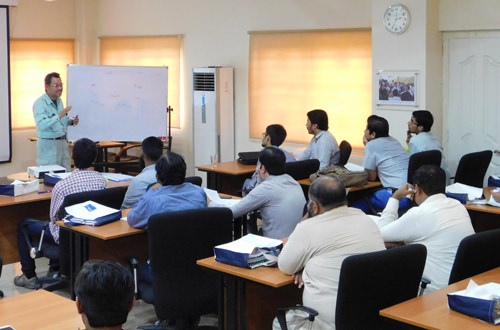
In order to break the vicious cycle of bridge inspections not being able to be carried out because bridge maintenance plans based on bridge inspections are not formulated, bridge repair budget requests cannot be made, and as a result bridge inspections cannot be carried out, we used the database as a core to raise awareness of the "bridge maintenance cycle" of inspection plans → bridge inspections → inspection result evaluations → maintenance plans → bridge repairs. We provided technical cooperation to ensure the continuous operation of the bridge maintenance cycle. This order had a significant impact on our subsequent overseas expansion.
2020s-2030s
2020
-
January 2020Merged with PACIFIC CONSULTANTS GROUP Co., Ltd.
2021
-
2021Takamatsu Airport Specific Operation Business, etc. (Airport Concession)
Aiming to Become the No. 1 International Airport in Shikoku and the Setouchi Area
Making Full Use of Domestic and International Consulting Know-how
We participated in a consortium represented by MITSUBISHI ESTATE CO., LTD., and won the right of first negotiation in 2017. We started business operations in April 2018. We have provided the necessary support for safe and secure airport operations by utilizing the comprehensive capabilities we have gained through our experience in numerous airport-related consulting projects, such as support for the launch of airport operations, support for the handover of national operations after operations have begun, and system creation. Today, we are promoting activities to attract new routes and the implementation of various measures in collaboration with local governments and related companies.
-
2021Mutsuzawa Smart Wellness Town Project
A new Challenge as a Leader in the Area
The Role of Private Companies in Regional Revitalization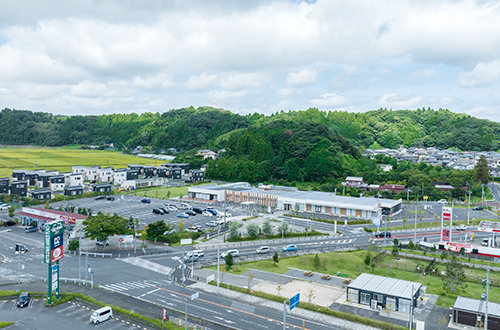
In August 2015, we proposed a "Smart Wellness Town Concept" to Mutsuwa Town in Chiba Prefecture, which would have roadside station as a base for local production and consumption of energy using locally produced natural gas, as well as housing to encourage relocation and settlement, and the concept was adopted. Roadside station will play a major role as a disaster prevention base for the region. The operation period of this project is 20 years, and our regional revitalization and challenges are just beginning. We will work to make this a showcase for one form of regional revitalization.
-
2021Project for Strengthening Resilience of Areas Affected by Cyclone Idai
Building Disaster-Resilient Cities in Africa
Minimizing Cyclone Damage with Japan's Cooperation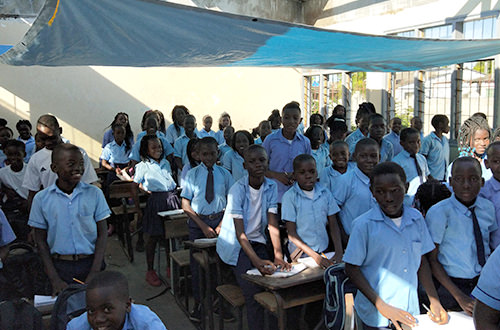
The powerful Cyclone Idai, which made landfall on March 14-15, 2019, caused extensive damage near Beira City in Sofala Province in the central part of Mozambique, Africa. The Mozambican government requested assistance from Japan. This project aims to support the formulation of an action plan for the Beira City Recovery and Reconstruction Plan and to develop a disaster-resistant city. Based on the hazard map, we promote understanding of disaster risks, promote smooth reconstruction work, and contribute to the creation of a disaster-resistant society.


